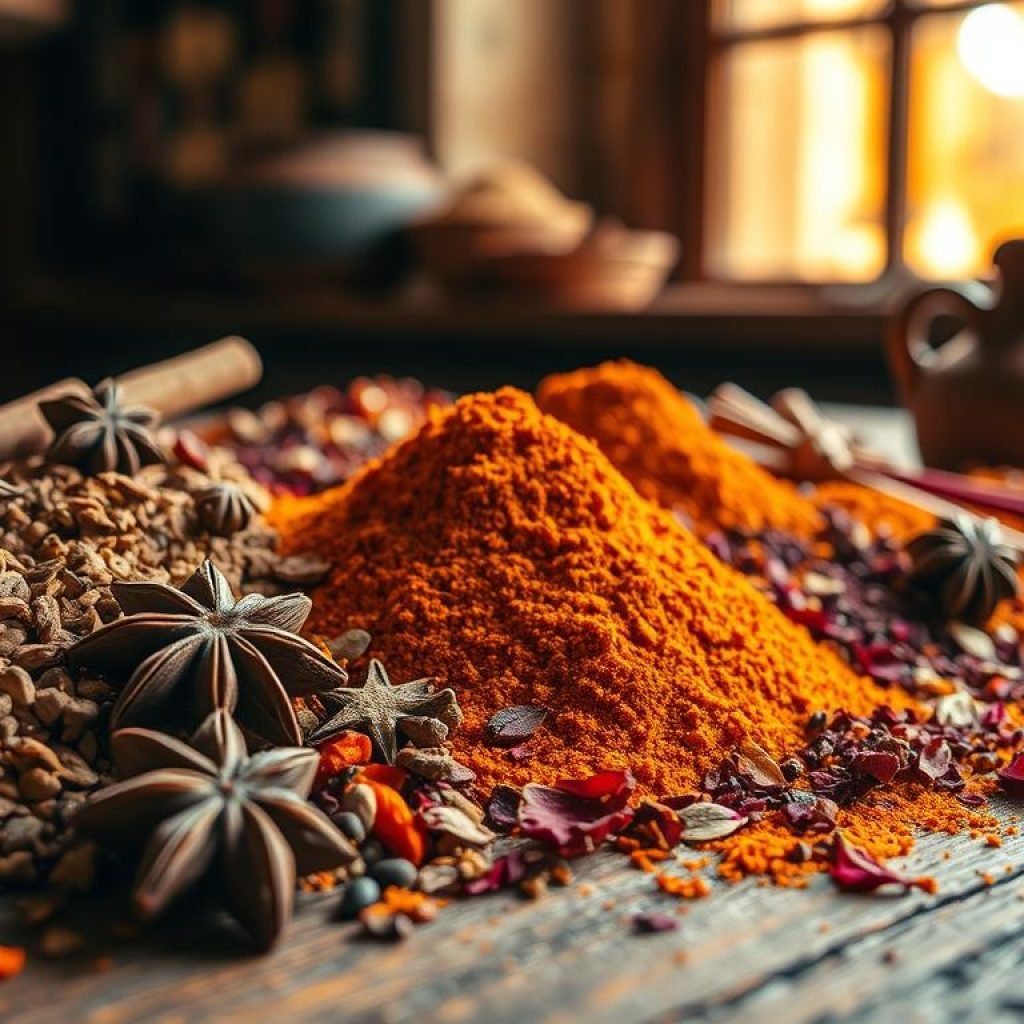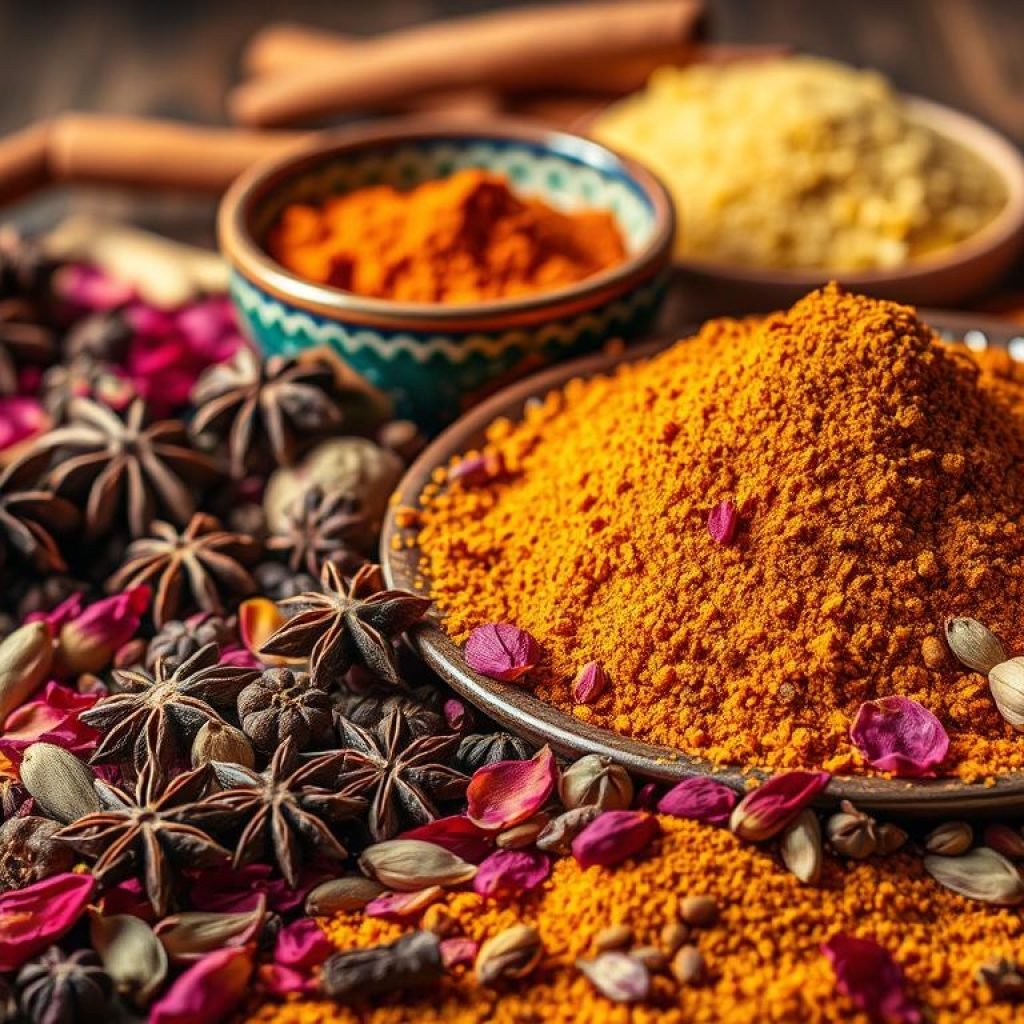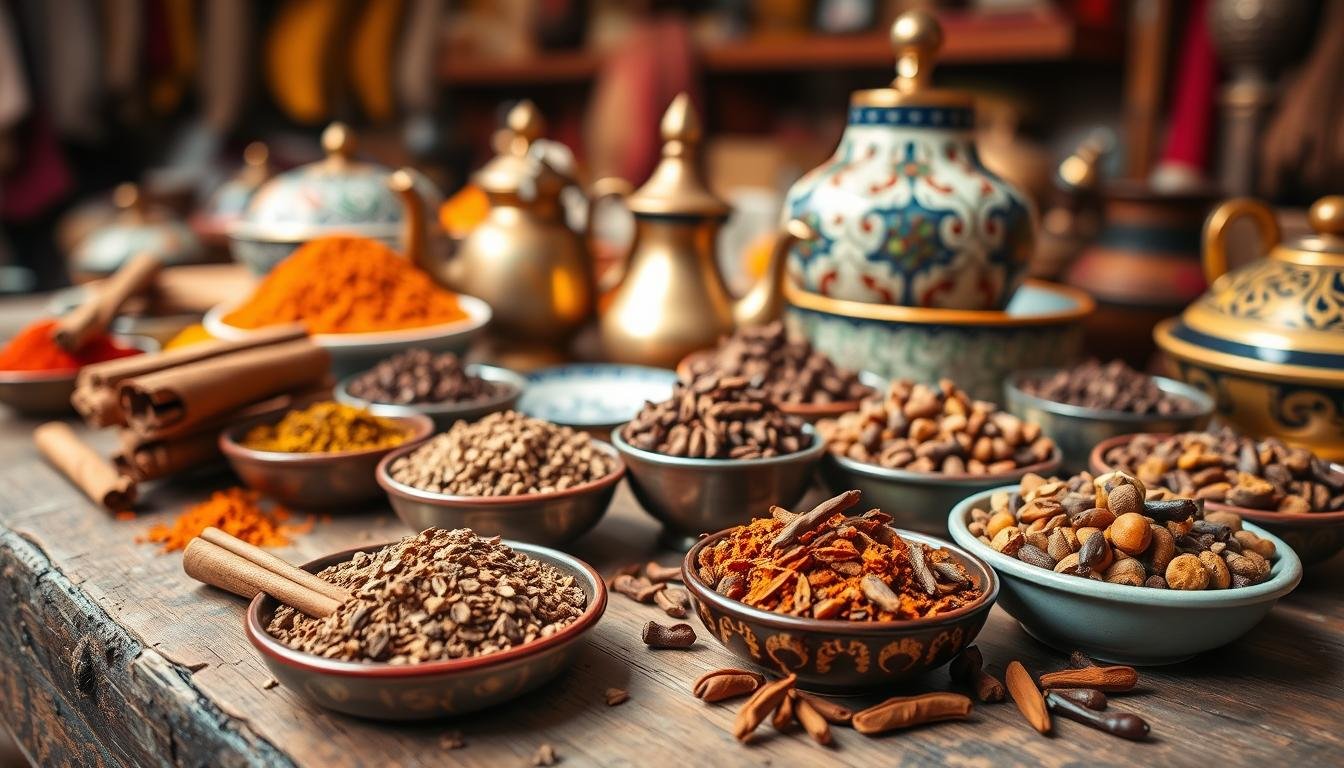What makes Moroccan desserts so special? They mix North African spices with rich flavors. These treats are enjoyed during mid-afternoon tea time, offering a sweet break from the usual.
With spices like cumin and coriander, and ingredients like dates and almonds, Moroccan spices are key. They help create these tasty desserts.
Chebakia is the top dessert during Ramadan. Moroccan desserts also offer gluten-free choices. Moroccan spices, like cinnamon and paprika, give these desserts a unique taste. They are definitely worth trying.
Introduction to Moroccan Desserts
There are at least 10 desserts for the Mimouna holiday and 8 Moroccan cake recipes. This shows there are many options. Moroccan desserts include chocolate, fruit, and gluten-free choices. This variety meets different dietary needs.
Key Takeaways
- Moroccan desserts are mainly enjoyed during mid-afternoon tea time
- Chebakia is the most popular dessert during Ramadan
- There are at least 10 specific dessert recipes for the Mimouna holiday
- Moroccan spices, such as cumin and coriander, are crucial in making delicious desserts
- Gluten-free options are available, catering to different dietary preferences
- Moroccan desserts are known for their unique blend of North African spices and rich flavors
Introduction to Moroccan Spices
Moroccan cuisine is famous for its herbs and spices. These add flavor, aroma, and depth to dishes. The country’s location at the crossroads of Africa, Europe, and the Middle East has made it a spice trade hub. This has led to unique spice blends that are key to Moroccan cooking.
For those wanting to try Moroccan cuisine, visiting local markets is a good start. As mentioned on Morocco travel tips, knowing local customs is key. Using herbs and spices in Moroccan cooking is more than just flavor. It’s about community and hospitality.
The role of spice blends in Moroccan cuisine is huge. Moroccan cooks have a wide range of herbs and spices to work with. This allows them to make complex, aromatic dishes that are both tasty and beautiful. Whether it’s the spice mix in traditional tagines or the simple use of herbs and spices in everyday meals, Moroccan cuisine shows the country’s rich cultural heritage.
Classic Moroccan Spices
Moroccan cuisine is famous for its rich use of spices. These spices are key to the country’s cooking identity. Cumin and saffron are two spices that stand out for their unique flavors and cultural importance.
These spices are vital in traditional Moroccan dishes. They also play a big role in the country’s spice trade history.
Morocco’s position on the spice trade route has shaped its cooking. This has led to a mix of spices like cumin, saffron, and others. These spices, along with other ingredients, make Moroccan dishes aromatic and flavorful.
- Cumin, known for its warm, earthy flavor
- Saffron, prized for its delicate, floral flavor and vibrant color
- Other exotic spices, such as ginger, turmeric, and cinnamon, which add depth and complexity to various dishes
Cumin and saffron are used in many Moroccan dishes. These include tagines, stews, salads, and desserts. The skill in blending these spices is essential in Moroccan cooking. It shows the country’s rich culinary heritage.
The Art of Blending Spices
Blending spices is an ancient art that has been perfected over time in various cultures. In Moroccan cuisine, cooking spices are key to flavor. Traditional spice blends, like Ras El Hanout, are iconic and used in many dishes.
The art of blending spices is about mixing different spices in specific ratios. This creates a unique flavor. Moroccan cuisine uses spices like cumin, coriander, turmeric, cinnamon, and paprika. The mix of these spices can make a dish mild, spicy, earthy, or aromatic.
Ras El Hanout: The Ultimate Spice Blend
Ras El Hanout, meaning “head of the shop,” is a classic Moroccan spice blend. It includes spices like cumin, coriander, cinnamon, and turmeric. This blend adds depth and complexity to dishes like tagines and couscous.
Creating Your Own Spice Blends
Creating your own spice blends can be fun and rewarding. By trying different mixes of cooking spices and traditional spices, you can make unique flavors. These can reflect your personal taste preferences.
Moroccan Spices in Modern Cooking
Moroccan spices are now key in modern cooking. Chefs and home cooks love to try new ways to use these flavors. They add cumin and coriander to veggies and saffron to desserts. Moroccan spices bring a unique taste to any dish.
Modern Moroccan cuisine is making traditional spices popular again. Morocco exports over 8 million dollars in spices globally. This has sparked a new interest in these flavors. Spices like cinnamon, cumin seed, saffron, and ginger are used in special blends for amazing tastes.

- Adding Ras El Hanout to soups and stews for a boost of flavor
- Using cumin and coriander to spice up vegetarian dishes
- Incorporating saffron into desserts for a luxurious and exotic flavor
- Blending North African spices with other international flavors to create unique and exciting dishes
Moroccan spices are becoming a must-have in kitchens worldwide. They add excitement and flavor to any dish. Whether you’re a pro or just starting, Moroccan spices are worth trying.
The Cultural Significance of Moroccan Spices
Moroccan spices are more than just ingredients in food. They symbolize hospitality and generosity in the country’s culture. The use of spice blends and herbs and spices shows respect and appreciation for guests. Morocco’s cuisine, with its 35 million residents, is a mix of Berber-Moorish, European, and Mediterranean flavors.
In Morocco, lunch is the main meal of the day. It often includes hot and cold salads, a meat dish, and spearmint tea. Spice blends like Ras El Hanout, with up to 100 spices, are crucial. The freshness and quality of herbs and spices are key for great flavor.
The importance of spice blends and herbs and spices is seen in Morocco’s lively spice markets. Here, you can find turmeric, paprika, and saffron. Saffron, valued more than gold, is a prized ingredient in many dishes.
Some key aspects of Moroccan spice culture include:
- The use of spice blends like Ras El Hanout as a rub for meats or in marinades
- The importance of freshness and quality in herbs and spices
- The significance of saffron in Moroccan cuisine, with its versatility in dishes like tajines, desserts, and teas
Exploring Moroccan Spice Markets
Moroccan spice markets are filled with flavors and aromas. They offer a wide range of spices. From Marrakech’s busy souks to Fez’s ancient markets, they are a must-see for food lovers and spice fans.
The spice markets in Morocco are famous for their unique blends. For instance, ras el hanout can have 6 to 20 different spices. Common spices in ras el hanout include cumin, nutmeg, and cinnamon.
The Souks of Marrakech
The souks of Marrakech are a top spot for spice seekers. Jemaa el-Fna square has been a trading center since the 11th century. Many spice shops in Fhal Zefriti and Mellah have been around for decades.
The Spice Markets of Fez
Fez’s spice markets are also a hit with spice lovers. The market has pickled and marinated goods, along with spices. Olives are a big deal here, thanks to Morocco’s food history. Ras el Hanout can have up to 30 spices, making it a complex mix.
These blends show Morocco’s rich culinary history. They highlight the role of spices in Moroccan food.
Cooking with Moroccan Spices
Cooking with Moroccan spices is an art that needs skill, patience, and practice. You can make tasty, authentic dishes by using traditional methods and modern ingredients. First, learn the basics of Moroccan cooking and avoid common errors.
Tips for Using Cooking Spices
When using traditional spices, balancing flavors and aromas is key. Choose high-quality spices like cumin, coriander, and cinnamon. Then, mix different spices to find the right blend for your dish. Feel free to add a little of this or that to make it unique.
Common Mistakes to Avoid
One mistake is using too much cooking spices, which can overwhelm other flavors. Another is not letting spices bloom, leading to a dull taste. To avoid these, start with small spice amounts and adjust as needed. Also, let spices bloom by toasting them or letting them sit for a few minutes.
By following these tips and avoiding common mistakes, you can make delicious Moroccan dishes. Remember to experiment, have fun, and enjoy cooking with Moroccan spices.
Moroccan Spices in Desserts
Moroccan spices are a key part of traditional desserts, bringing a unique flavor. They add a special taste to sweet dishes. Cinnamon, ginger, saffron, and Ras El Hanout are used in both old and new desserts.
Spices in Moroccan desserts are used with care. They enhance the natural flavors of fruits and veggies without being too strong. Spices like cinnamon, nutmeg, and cardamom add warmth and aroma. Ras El Hanout, with its mix of spices, is a must-have for desserts.
Popular desserts like Moroccan spiced oranges and fruit platters show off these spices. They use fruits like apples, bananas, and oranges. Adding spices like cinnamon and anise seeds makes these desserts even more special.

Adding Moroccan spices to your desserts can make them more interesting. Whether you’re making traditional desserts or just want to spice up your treats, Moroccan spices are a great choice. They bring a unique and delicious twist to any dessert.
The Health Benefits of Moroccan Spices
Moroccan spices are famous for their unique flavors and smells. They also have many health benefits. The mix of herbs and spices in Moroccan food has helped people stay healthy for centuries. Turmeric and ginger fight inflammation, while cumin and coriander are full of antioxidants.
The spice blends used in Moroccan cooking are special. Ras El Hanout, for example, can have up to 30 spices. Each spice has its own health perks. Turmeric fights inflammation, ginger soothes the stomach, and cumin helps control blood sugar. Saffron even helps with depression.
- Anti-inflammatory properties: Turmeric, ginger, and other spices help reduce inflammation and alleviate symptoms.
- Antioxidant properties: Cumin, coriander, and other spices provide antioxidant benefits, protecting against cell damage and promoting overall health.
- Improved digestion: Ginger, cumin, and other spices aid digestion and reduce nausea.
Adding Moroccan herbs and spices to your meals can greatly improve your health. They add amazing flavors and smells to your food. Plus, they support your health. If you want to feel better or eat healthier, try Moroccan spice blends.
Moroccan Spices in Modern Medicine
Moroccan spices have been used for centuries in traditional medicine. Now, modern medicine is recognizing their health benefits. Culinary spices like turmeric, ginger, and cinnamon help with various health issues.
The use of exotic spices in medicine is growing. Studies show they have many health benefits. For example, saffron can help with anxiety and depression because of its anti-inflammatory properties.
The Science Behind Spice-Based Medicine
Moroccan spices are used in many modern medical treatments. They help with arthritis, anxiety, and depression. Some key spices include:
- Turmeric, which contains curcumin, a powerful anti-inflammatory compound
- Ginger, which has anti-nausea and anti-inflammatory properties
- Cinnamon, which has anti-inflammatory properties and may help lower blood sugar levels
Using Spices in Contemporary Medicine
Moroccan spices are not just for traditional remedies anymore. Modern medicine is using them too. By adding culinary spices and exotic spices to our diet, we can improve our health and wellness.
Where to Buy Moroccan Spices
There are many ways to buy Moroccan spices. Online stores like The Spice House have a wide range of cooking spices and traditional spices. They offer blends like Marrakesh Market Blend, which has 14 ingredients and comes in a flatpack or jar.
Specialty food stores are also a good choice. They have lots of cooking spices and traditional spices. The staff can help you pick the right spices and give tips on how to use them. Stores like Sur La Table and Williams-Sonoma have Moroccan cookbooks that show how to use these spices.
For a personal touch, try a local spice market or specialty store. They have a wide variety of traditional spices and cooking spices. The staff can give you advice on using the spices. You can also learn about Moroccan travel mistakes to make your trip better.
Some popular blends include Marrakesh Market Blend. It adds depth to dishes without being too strong. It’s great for Tagines and North African dishes. You can buy it in a flatpack or jar, both 2.4oz. Buying a curated spice bundle saves you 5% and comes with recipes.
Conclusion
Our journey through Moroccan spices has shown us their deep connection to the country’s food culture. Essential spices like Ras El Hanout and saffron have shaped North African flavors. Whether you’re a pro chef or just starting, exploring Moroccan spices can open up new flavors in your cooking.
Moroccan spices are more than just ingredients; they carry cultural and historical value. The spice markets of Marrakech and the traditions of Moroccan hospitality are just a few examples. As you dive into Moroccan cuisine, let the bold flavors, vibrant colors, and stories of these spices enrich your experience.




Comment (0)